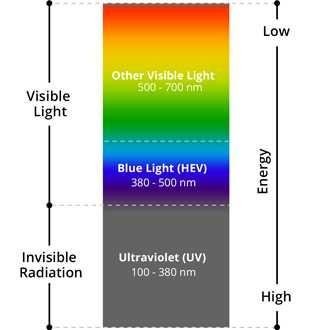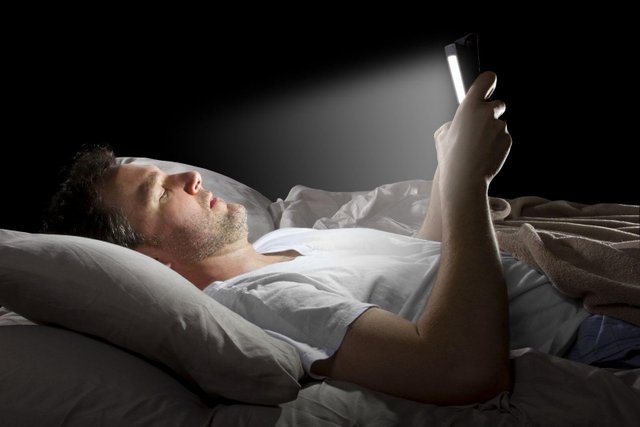BLUE LIGHT
Every day, we wake up to the beautiful blue sky, and to the warm sun shine for those of us in West Africa. From switching on the light on waking up to operating different electronic devices, it is usually a light filled day.
The light we see is made up of diverse visible, and sometimes invisible, light rays that have a range of effects. Light is generally made up of electromagnetic particles that travel in waves. The shorter the wavelength, the higher the energy. Usually every wavelength is represented by a different colour.

Source: www.allaboutvision.com
Sunlight for instance, contains red, orange, yellow, green and blue light rays and many shades of each of these colours, depending on the energy and wavelength of the individual rays.
As stated earlier, lights with short wavelengths have high energy, and those with long wavelengths have less energy. This therefore means that rays on the red end of the visible light spectrum with longer wavelengths will have less energy, compared with rays on the blue end of the visible light spectrum with shorter wavelengths and more energy.
The visible light spectrum is said to be comprised of electromagnetic radiation with wavelengths ranging from 380nm on the blue end of the spectrum to about 700nm on the red end.
Blue light itself is defined as visible light ranging from 380nm to 500nm.
It is worthy of note that approximately one - third of all visible light is considered high-energy visible or "blue" light.
The fact is blue light is all around us. From the sunlight, fluorescent and LED lights, flat screen televisions, e.t.c, all emit blue light.


Digital devices such as smartphones, and computer display screens emits significant amount of blue lights but not as much as the sun. But the amount of time we spend using these devices and the proximity of these screens to our face, is a serious cause of concern.

Source: health.havard.edu
Studies have suggested that 60% of people spend more than 6 hours a day in front of a digital device. According to the website, bluelightexposed.com, over time, exposure to the blue end of the light spectrum could cause serious long-term damage to the eyes.
Naturally, the body uses blue light from the sun to regulate it's circadian rhythm, that is, the natural sleep and wake time. Blue light also boost alertness, heighten reaction times, elevate moods, and increase the feeling of well being.
WHY SHOULD WE BE CONCERNED
As stated earlier, blue light waves are among the shortest, highest energy wavelengths in the visible light spectrum. Because of this, "Blue" or High Energy Visible (HEV) wavelengths flicker more easily. This flickering results in glare which causes reduced visual contrast.
This flickering and glaring may be one of the reasons for eyestrain, headaches, physical and mental fatigue caused by many hours sitting in front of a computer screen or other electronic devices. This is according to bluelightexposed.com. The website also stated that prolonged exposure to blue light may cause retinal damage and contribute to age-related macula degeneration, which can lead to loss of vision.
The May 2012 Harvard Health letter outlined the health risks of nighttime light. It stated that studies have linked working the night shift and exposure to light at night to several types of cancer (breast, prostate), diabetes, heart diseases, and obesity.
The health letter further stated that exposure to light suppresses the secretion of melatonin, a hormone that influences circadian rhythms, and that there is some experimental evidence that lower melatonin levels might explain the association with cancer.
Light at night is part of the reason so many people don't get enough sleep, and researchers have linked short sleep to increased risk for depression, as well as diabetes and cardiovascular problems, notes Stephen Lockley, a Harvard sleep researcher.
WHAT THEN CAN WE DO
The Harvard Health letter mentioned earlier recommends the following;
- Use dim red lights for night lights. Red light has the least power to shift circadian rhythm and suppress melatonin.
- Avoid looking at bright screens beginning two to three hours before bed.
- If you work night shift or use a lot of electronic devices at night, consider wearing blue-blocking glasses or installing an app that filters the blue/green wavelengths at night.
- Expose yourself to lots of bright light during the day, which will boost your ability to sleep at night, as well as your mood and alertness during daylight.
I hope you've been able to learn what blue light is, the dangers of over exposure, and what you can do to manage the blue lights around us?
Feel free to share your thoughts in the comment section.
All images without source, are mine and was taken with my phone camera.
REFERENCES
http://www.allaboutvision.com/cvs/blue-light.htm
https://www.health.harvard.edu/staying-healthy/blue-light-has-a-dark-side
http://www.bluelightexposed.com
Thank you for reading...
Thanks for sharing @sunnyebinum .
Our eyes need some protection. Thanks for the heads up.
True @bitfairy. It's very important we protect our eyes at all times.
A photochromic lens with antireflective properties should be able to protect the eyes from these radiations to an extent. You can talk to your Optometrist about one...
Wow thanks for the lecture
You're welcome... and thanks for dropping by, i really appreciate it.